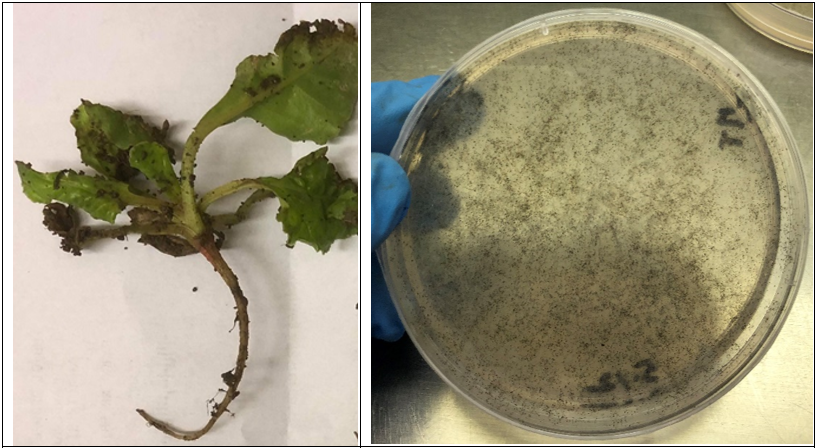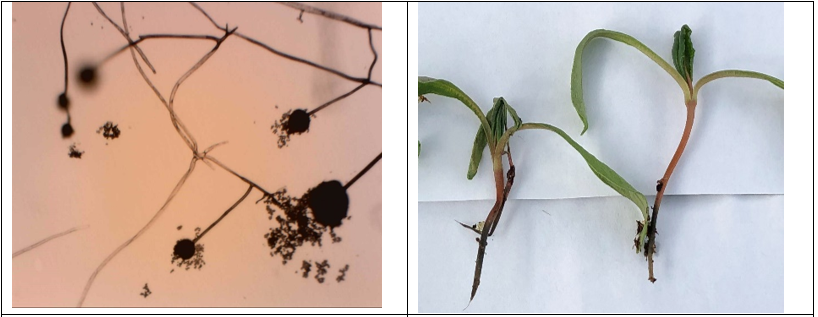Short Communication
Volume 4 Issue 1 - 2022
First Report of Rhizopus causing Hypocotyl and Root Rot in Sugar Beet (Beta vulgaris. L) Seedlings in Montana, USA.
1North Dakota State University, Fargo, ND 58203
2Bangladesh Agricultural Research Institute, Joydebpur, Gazipur-1701, Bangladesh
2Bangladesh Agricultural Research Institute, Joydebpur, Gazipur-1701, Bangladesh
*Corresponding Author: Most Shanaj Parvin, Bangladesh Agricultural Research Institute, Joydebpur, Gazipur-1701, Bangladesh.
Received: December 29, 2021; Published: January 08, 2022
Sugar beet is commercially grown in Minnesota, Idaho, North Dakota, Michigan, Nebraska, Montana, California, Wyoming, Colorado, Oregon, and Washington [3]. The cultivars are relatively high-yielding and are moderately resistant to most of the common soil-borne and foliar pathogens. Most cultivars have a minimum level of resistance to root pathogens such as Rhizoctonia solani, Aphanomyces cochlioides, Clonostachys rosea, Globisporangium ultimum, Rhizopus stolonifera, and Fusarium equiseti [1, 2, 3, 4]. In June 2019, sugar beet seedlings were observed with hypocotyl and root rot in Sidney (47.7167° N, 104.1563° W), Montana. The disease affected about 20% of the 10 ha commercial field (Figure 1). Hypocotyl of infected seedlings was surface sterilized with 70% ethanol for 30 seconds, rinsed with sterile distilled water, and cultured on 10% water agar (WA) for 7 days at 25°C. Macroscopically, on WA the colonies had profuse white cottony mycelia with black dot-like heads (Figure 2). Microscopically, the sporangiophores developed in groups (3 to 5) simple rhizoids and stolons at their ends (Figure 3). The globose sporangia were large with a size of 90.24 (50.67 to 140.55) µm, and the sporangiospores ranged from ellipsoid to ovoid and measured 5.55 (5.00–8.14) μm × 3.4 (2.92–5.46) μm. Based on the morphological characteristics, the fungus was identified as Rhizopus stolonifer [5]. Pathogenicity assay was done using 8, 2-week old sugar beet seedlings grown individually in pots (4?×4?×6?). Seedlings were inoculated with a mycelial plug which was kept close to the seedlings. Inoculated and control plants were placed in the greenhouse at 25 ± 2°C, and 80% to 85% relative humidity. In 4-5 days, six out of 8 inoculated seedlings showed symptoms similar to those observed in the field and non-inoculated seedlings were symptomless. This study was repeated (Figure 4). The fungus was isolated from diseased roots and confirmed to be Rhizopus stolonifer based on morphological characters. Rhizopus stolonifer and R. arrhizus are the most common fungi mostly found in moist agricultural soils. Rhizopus stolonifer causes disease at low temperatures of 57° to 61°F. Recently, Globisporangium ultimum was reported to cause constriction on hypocotyl of sugar beet seedlings [4]. To our knowledge, this is the first report of Rhizopus stolonifer causing hypocotyl and root rot on sugar beet seedlings in Montana.

Figure 1: Infected sugar beet hypocotyl rot collected from the field in Montana.
Figure 2: Appearance of Rhizopus grown on water agar.
Figure 2: Appearance of Rhizopus grown on water agar.

Figure 3: Morphological characteristics of Rhizopus.
Figure 4: Symptoms on sugar beet seedlings inoculated artificially with Rhizopus.
Figure 4: Symptoms on sugar beet seedlings inoculated artificially with Rhizopus.
References
- Haque ME, Parvin MS (2020). First Report of Aphanomyces Root Rot Caused by Aphanomyces cochlioides on Beta vulgaris in Arizona, USA. J Plant Physiol Pathol. 8:4.
- Haque ME, Parvin MS, (2020). First report of Clonostachys rosea causing root rot of Beta vulgaris in North Dakota, USA.New Disease Reports 42, 21.
- Haque, ME., Parvin MS. (2021). Sugar beet, its Disease Rhizoctonia Root Rot, and Potential Biological Agents. AGBIR. 37(1): 96-101.
- Haque, ME., Parvin, MS. (2021). First Report of Globisporangium ultimum Causing Constriction on Hypocotyl of Beta vulgaris in North Dakota, USA. Austin J Plant Biol. 7(1): 1025.
- Lin, C. P., et al. (2017). Plant Dis. 101:254. https://doi.org/10.1094/PDIS-07-16-1033-PDN Link
Citation: Md Ehsanul Haque and Most Shanaj Parvin. (2022). First Report of Rhizopus causing Hypocotyl and Root Rot in Sugar Beet (Beta vulgaris. L) Seedlings in Montana, USA. Journal of Agriculture and Aquaculture 4(1).
Copyright: © 2022 Most Shanaj Parvin. This is an open-access article distributed under the terms of the Creative Commons Attribution License, which permits unrestricted use, distribution, and reproduction in any medium, provided the original author and source are credited.
